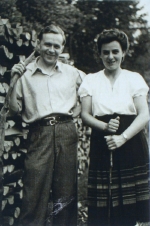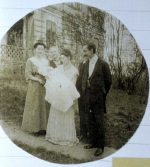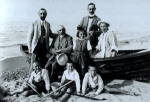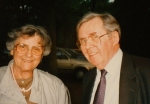
| Family history | ||
| Extract from Karlgeorg Hoefer’s Memoirs, handwritten in 1999. |
||
 |
||
| My Maternal Grandparents The textile factory owner Georg Alfred Dinglinger (born July 26, 1857 in Berlin) married Else Bergmann (born November 11, 1859 in Berlin) on June 29, 1883. Thereafter, they lived in their Wüstegiersdorf Villa in Waldenburg/Schlesien County. They had two children. My uncle Curt was born on December 20, 1885, and my mother Helen was born on November 20, 1888. My grandparents were particularly close to my heart, especially my grandmother! |
||
 |
||
| I could write at length about my first chores; it was through them that I got my childhood allowance. I earned this by dusting pristine museum-like rooms and weeding the garden. The money added up over time. I often used to visit a stationery store in our town, where my eyes would fix wistfully upon the printing equipment. With the allowance money I had saved up, I bought a fountain pen. Herr Marx, who ran the store’s printing shop, also printed a few business cards for me. These purchases infuriated my father, who had neither a fountain pen nor business cards of his own. Even though he was infuriated by these things, it was exactly these lovely transactions with my grandmother, and my infatuation with the local stationery business, that decided my later professional career! I first began to earn real money as a type setter. In trade school, I was introduced to rudimentary calligraphic techniques: quill pens and India ink. My unforgettable beginning in the Riesengebirge carried me to an apprenticeship in Hamburg, and then to art school in Offenbach, where I met Maria. My father paid for my education, and in Offenbach I worked diligently to earn extra money. One job I had was to cut type silhouettes for Dr. Karl Klingspor. These began to accumulate into a sizable collection for admirers in Kronberg. At school, I received my first award: a citation from the hand of the director himself, Prof. Dr. Hugo Eberhardt. These were the Klingspor prizes; my friend Joachim Romann was awarded first place, while I came in second. The prize included 50 marks in pocket money, which was to be used for student materials. I can still remember the reaction back home in Wüstegiersdorf! My father looked on with bewilderment, surprised at how spoiled the family’s four grandchildren had become. I especially remember one episode. An invitation arrived on my bed in the billiard room. Head Forester Schwarz had invited me on a hunting and fishing trip. I knew that my father would not approve of my leaving so early in the morning, so I left a note for him explaining where I was going – and away I went. I had such a wonderful experience that morning in the woods, too!!! On my way home though, I happened to pass my father, who was walking along the other side of the street. I couldn’t understand his reaction, but he ordered me to go home immediately! I’ve never been able to forget this; the young son had had a wonderful experience, but since I hadn’t asked for his permission, I received a bitter reproach. My parents met each other in Hirschberg, in the Riesengebirge. My maternal grandparents had moved their from another spinning works factory town. Many family get-togethers were celebrated in Hirschberg. My mother’s brother, Curt Dinglinger, was a Pastor in the area, just like my father. Curt was married to Mathilde Huhndorf. A curious thing happened to both the Hoefer and the Dinglinger families on February 6, 1914: they each bore sons. We were named Karlgeorg and Hans Georg (my cousin Hans Georg died in the Second World War), and our grandfather filed an announcement in the newspaper Boot aus dem Riesengebirge to announce both of our births. Also worth mentioning is that both of the fathers (Otto Hoefer and Curt Dinglinger) shared the same birthday as well (December 12)! But in their case, they were born one year apart from each other, instead of on the exact same day. My parents filled between 15 and 24 pages of a diary with a detailed description of my early childhood. After reading these pages, I was able to re-experience the love that my mother had for me, which I unfortunately had to share after my brother Gottfried was born. My mother died on December 12, 1930 in Lüben, a Silesian spa town. My father then took a second wife, marrying the maid, Steffi Berger, who died shortly thereafter. Her sister became my father’s third wife. Margerete Berger was born on April 21, 1895. She outlived him, and was buried in 1987, in Miltenberg. |
||
My Paternal Grandparents Geheimrat Otto Hoefer wrote in 1905 for his both sons a 700 page book with his youthful memories. "Jugenderinnerungen des Geheimrathes Hoefer". This was handwritten in "German Kurrent script", which is hard to read. Now it is available as a published book in german edition via BoD. . |
||
 |
||
 |
||
| Maria Hoefer Maria’s passion was the design of artistic patchwork quilts: for years, she took classes in Darmstadt and Mühlheim with renowned craftsman from all over Germany and the rest of the world, but she had never had a solo exhibition of her own. Over many years, she built up a solidly independent body of work in textile design. I became determined to organize an exhibit for her. Like a miracle, an opportunity arose in the German Leather Museum right before her death. Frau Ringwald and the Minister of Culture, Frau Lydia Gesenhus, were responsible. They chose to honor the couple Maria and Karlgeorg Hoefer with a joint exhibition from September 3–19, 1998. Prof. Dieter Linke from the College of Design in Offenbach (Hochschule für Gestaltung) gave the introductory speech. Minister of Culture Stephan Wildhirt greeted the multitude of guests that arrived at 7 pm on the third of September. The theme of the exhibition was “The Joy of Creativity,” and Maria’s patchwork pieces were the majority of the works on display. . |
||
 |
||
| The following review appeared in the Frankfurter Allgemeine Zeitung on September 5, 1998 (translated from the original German): The “Calm Serenity” of a Calligraphic Life The Husband and wife exhibition of the work of Karlgeorg and Maria Hoefer 74 pieces and calligraphic samples on display in the German Leather Museum The city of Offenbach paid tribute to the artistic pair of Karlgeorg and Maria Hoefer with an exhibit of their work, which opened on Thursday night in the German Leather Museum. Before a crowd of over 200 guests, the mayor and Minister of Culture Stephan Wildhirt (SPD) explained that the internationally renowned letting artist Karlgeorg Hoefer, together with his wife, the illustrator Maria Hoefer, have extraordinarily enriched Offenbach’s cultural sphere. Because of this, the city that has long played host to them has chosen to honor them with this exhibition, the title of which seems to be the Hoefers’ motto: “The Joy of Creativity.” Hoefer, who the city of Offenbach has already awarded its silver medal, and who has also received the German Federal Service Cross (Bundesverdienstkreuzes am Bande), then thanked the city council for the exhibition. He said that he has taken great pleasure in exhibiting a portion of his and Maria’s creative output before the city in which they have resided for over a half century. Visibly moved by the crowd, he thanked the guests as well for their attendance. Most of the guests were friends of the Hoefers, fellow calligraphers, or former students. The opening was part of the “First Offenbach Cultural Festival,” which will include a warm variety of other cultural events before ending tomorrow. On display in the German Leather Museum are 74 pieces from Karlgeorg and Maria Hoefer. Additionally, multiple writing instruments and a selection of books have been arranged for view. In one piece found between exhibitions, entitled “Wealth of Imagination,” Hoefer describes his own artistic creed: “The writing of today is not only based on the wealth of forms from the past, but also on personal expression.” One of the exhibited works from Hoefer’s early years (he is 84 years old) is a poster entitled “Applied Arts,” that was created for a 1950 exhibition at the former College of Applied Arts in Offenbach (Werkkunstschule Offenbach). Pages of writing display quotes and passages from poets, authors, philosophers, as well as the Bible, and show a wide variety of calligraphic techniques, ranging from fine hair liners to felt tipped markers. Also documented in the exhibition are Hoefer’s contributions to the reform of the instruction of writing in primary schools; Hoefer once took part in a study aimed at school teachers, which was sponsored by the city and county of Offenbach. Maria Hoefer exhibited 11 large format works that were created using patchwork techniques. Also on display were drawings and a concertina book entitled “Bäume durften im frischen Gras.” This contains prints that she created together with her husband. The prints make up a sort of alphabet cycle. In the eyes of Dieter Lincke, professor of drawing and illustration at the College of Design in Offenbach, the exhibition managed to present a concentrated view inside the creative lives of these two artists, although it is not a complete retrospective. A “calm serenity” can be felt within all of the works on display. The Hoefers show that everyday life can be creative. Lincke further put forward, that while Karlgeorg Hoefer’s work has maintained a unified oeuvre throughout his career, Maria Hoefer’s focus came later in her life. Work that she created in her 80s presents a youthful curiosity and ability. The common thread throughout the Hoefers’ work lies in a balance between spontaneity and strength. Lincke also credited the couple with a further role: it was they who brought the new American calligraphic movement to Germany during the early 1980s. Without their artistic activity on both continents, this would not have been possible. In his speech, Lincke sketched out the lives and work of these artists, who in the mid 1930s both studied at the Offenbach Technical College, a forerunner of the old College of Applied Arts and today’s College of Design. It was in Offenbach that the two got to know each other. Maria Hoefer had completed an apprenticeship in the textiles departments, and studied book design and illustration from 1935 until 1939 with Willi Harwerth. Karlgeorg Hoefer, who had been previously trained as a type setter, studied calligraphy and typography from 1937 until 1939 with Harwerth and Ernst Engel. After Karlgeorg Hoefer became a calligraphy teacher at the Offenbach Master School of Arts and Crafts (Meisterschule für gestaltendes Handwerk), another forerunner of the College of Design, he decided that the city of Offenbach would serve as the center of his personal and professional life. Hoefer taught at the school for 33 years, until his retirement in 1979. Lincke, who studied under Hoefer in the 1960s, discussed the balance between tradition and modernity in calligraphy. Hoefer was against the slave-like repetition of historical styles; he advocated for individual creativity, and believed that a personal style would develop within his students. This belief was evident in his own work through his interest in the interaction of various writing instruments with different styles. For example, it was the Brause 505 Feder, a pen that he developed himself, which inspired him to design the “Salto” typeface. He used a pointed brush to create the typeface “Zebra,” and the “Permanent” typeface was inspired by his drawings. He used Japanese brushes so much in his work that they have become a characteristic identifier. Hoefer used newer technologies to his advantage as well: he designed the first digital typeface for the Greek telephone books, as well as the lettering system for the “Euro” license plate design in Germany. The contribution of the 85-year old Maria Hoefer in her husband’s work is very evident, reiterated Lincke, but she undertook many artistic projects of her own, especially those which she made during her stays in the United States. Excited by the working environment there, she began using patchwork techniques. Through these, she found her right methods of expression, and was able to establish a free and independent artistic identity for herself. Her abstract textile wall hangings almost always include a representational or narrative element. |
||
| Calligraphy | |
| Works | |
| Typefaces | |
| Workshops | |
| Family history | |
| Live story | |
| Links | |
| Contact |